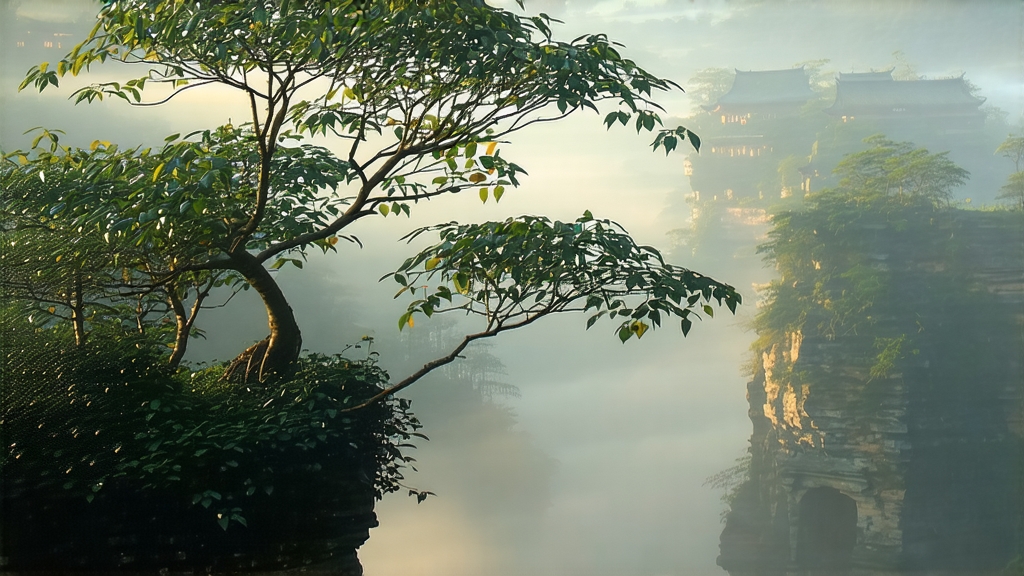
High in the mist-crowned Wuyi Mountains of northern Fujian, narrow plank paths still cling to sheer cliffs where monks once gathered tea in wicker baskets lowered on bamboo ropes. It is here, in a micro-climate of mineral-rich ravines, morning fog, and reflected river light, that Da Hong Pao—literally “Big Red Robe”—was first recorded in the late Ming dynasty. A single legend binds every retelling: an imperial scholar, en route to the capital, fell ill at the Nine-Dragon Gorge. Monks brewed leaves from six ancient bushes growing from crevices in the rock; the scholar revived, passed the palace exams, and returned in crimson robes to drape the bushes in gratitude. The name stuck, and so did the mystique. Today those mother trees, aged more than 350 years, stand protected by court decree; their offspring, propagated through cuttings, carry the same genetic song into gardens scattered across the Wuyi reserve.
Da Hong Pao belongs to the rock oolong family, yancha, a style defined by the “rock bone and floral heart” that only decomposed volcanic tuff, diurnal temperature swings, and a river’s reflective humidity can bestow. Within yancha, Da Hong Pao is not a single cultivar but a blend of selected bushes—often Qi Dan, Bei Dou, and Que She—each contributing layers of aroma, texture, and lingering mineral echo. Purists speak of three tiers: mother-tree (harvests ceased in 2006), pure-clone (trees directly grafted from the originals), and commodity blends that marry compatible Wuyi cultivars to approximate the legendary cup. All, however, must pass through the same labor-intensive choreography that turns stiff alpine leaves into curled, obsidian-striped oolong.
Plucking begins in late April when two leaves and a bud still wear a faint down and the morning mountain air smells of river reeds. The baskets must reach the factory—usually a stone-built cottage whose rafters are blackened by decades of charcoal smoke—within two hours; oxidation waits for no one. Inside, the leaves are shaken, tossed, and bruised on large bamboo trays in a process called yaoqing, “rocking the green,” where rhythm is dictated by the moisture on the leaf’s edge. Masters listen for a faint rustle like silk against porcelain; that is the moment when cell walls crack just enough to free aromatic enzymes without bruising the vein. Next comes brief sun-withering on rush mats, then a 250 °C tumble in a rolling drum roaster for sixty seconds—long enough to halt oxidation at 40–50 %, leaving the leaf margins amber while the core stays jade.
What follows is the Wuyi signature: three separate charcoal roasts, each cooler and longer than the last. First firing at 120 °C for two hours drives residual moisture from the stem; the leaf rests in linen sacks for seven days so internal water migrates outward. Second firing drops to 90 °C for four hours, coaxing caramelized sugars and anchoring the tell-tale “rock rhyme.” The final bake, barely 70 °C, can stretch ten hours and is judged by aroma alone: when the room fills with the scent of toasted chestnut and orchid, the tea is finished. In between each roast the leaves are hand-sorted, stripped of stems, and coaxed into the tight, glossy twists that resemble miniature pieces of petrified pine bark.
To brew Da Hong Pao gongfu style, choose a small Yixing teapot seasoned only for yancha; its porous clay has already memorized minerals from earlier infusions and will amplify the stone note. Heat the pot with just-boiled spring water, then fill one-third with leaf—far more than seems polite, but the rolls must unfurl. The first flash rinse, discarded after three seconds, is called “awakening the rock.” Subsequent steeps begin at five seconds, adding two each time; a quality Da Hong Pao will yield eight clear infusions before surrendering. Water should be 98 °C and low in calcium; hard water dulls the metallic snap that connoisseurs call “the taste of the gorge.” Pour in a thin stream along the pot wall to avoid scalding the leaves, then decant completely; lingering liquor will stew the subtle orchid into flat tannin.
Lift the first cup to the light: the liquor glows like burnished topaz. Inhale without sipping—top notes of